The Samsung Galaxy S6 and S6 edge Review
by Joshua Ho on April 17, 2015 9:00 AM EST- Posted in
- Smartphones
- Samsung
- Mobile
- Galaxy S6
- Galaxy S6 Edge
NAND Performance: The First UFS Phone
Storage performance is often a critical area for user performance, as applications cannot be cached in RAM at every possible moment. Camera performance is also often limited by storage performance as RAM buffers can only do so much to maintain performance before it’s necessary to commit photos to non-volatile storage.
However due to the memory hierarchy to some extent, storage performance is often hard to notice once it’s at a point where things are “good enough”. Unfortunately, in some cases we can see OEMs failing to include sufficiently performant solid-state storage, which can be a major pain point in the user experience when random read/write performance is low enough that there are noticeable IO pauses as the system has to wait for data to be loaded from storage.
The Samsung Galaxy S6 family is the first shipping implementation of UFS (Universal Flash Storage) 2.0 standard, which makes the internal storage model less like an SD card in nature. When comparing the eMMC 5.1 standard to the UFS 2.0 standard, we see a move from a the 400 MB/s maximum of the eMMC 5.1 standard with HS400 physical link interface to MIPI M-PHY, which allows for a theoretical maximum of around 720 MB/s and should be more efficient in transmitting data than the current eMMC standard. In addition, UFS makes it possible to do full duplex communication, which means that reads and writes can happen simultaneously. There's also a command queue, which helps to avoid inefficiencies that could arise from waiting for commands once a command has been processed by the storage controller, and utilizes the SCSI protocol to facilitate these new features at the interface level.
As for the Galaxy S6 itself, the UFS implementation Samsung is using is Samsung developed. Samsung's current implementation only supports up to 300 MB/s (or 2.4 Gbps) transfer rates as a theoretical maximum, so from an interface perspective it's still not reaching the full capabilities of the standard. Though even at a cap of 300MB/sec, it still stands to be a significant improvement over typical eMMC solutions.
Finally, on a technical note, the 32GB models are of the model KLUBG4G1BD-E0B1 with a maximum queue depth of 16.
In order to test storage performance, we use Androbench with some custom settings to get a reasonable idea of performance in this area, although this test isn’t an exhaustive examination of storage performance by any means.
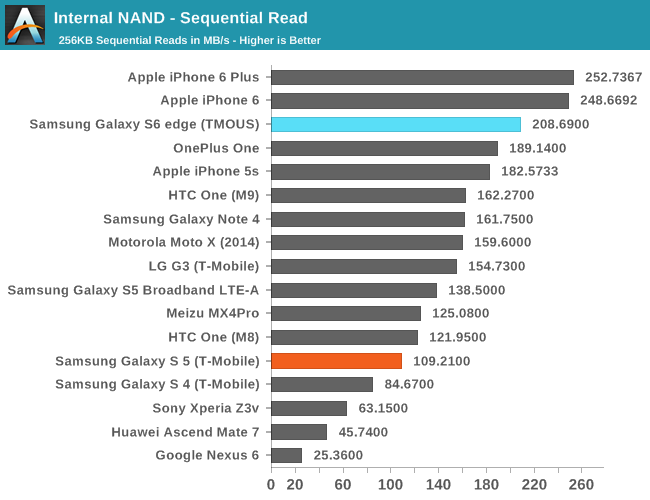
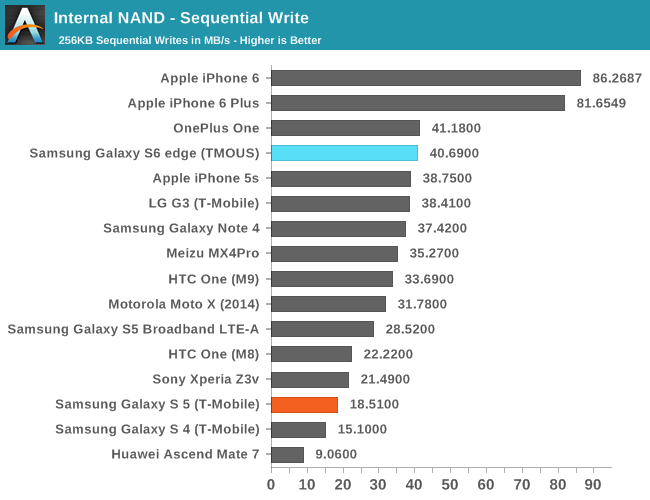
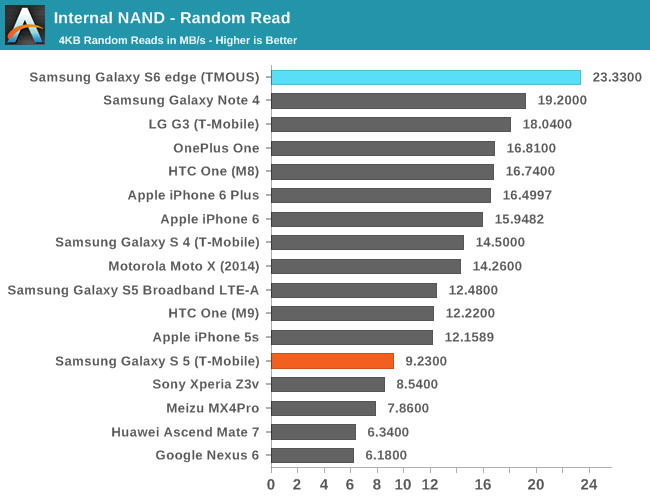
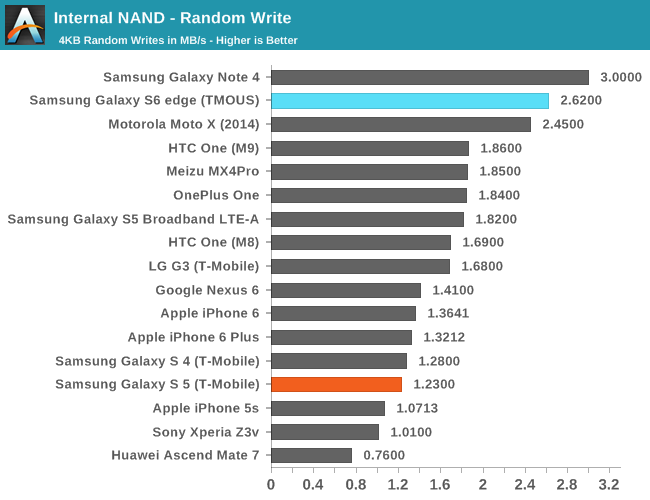
The Galaxy S6 performs rather impressively in our standard storage test, but not as fast as one might have hoped. This is due to the nature of the Androbench 3.6 test, which only tests a single IO thread, which won’t use the UFS storage of the Galaxy S6 to its full extent. In order to see the kind of difference that UFS really makes, I ran the same test again on Androbench 4.x, which does support multiple IO threads. However, as our iOS storage test and Androbench 3.6 don’t support more than a single IO thread we will continue to present both results for now.
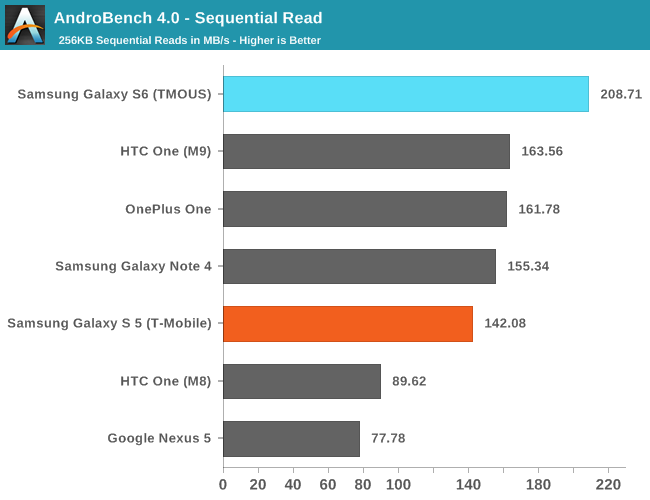
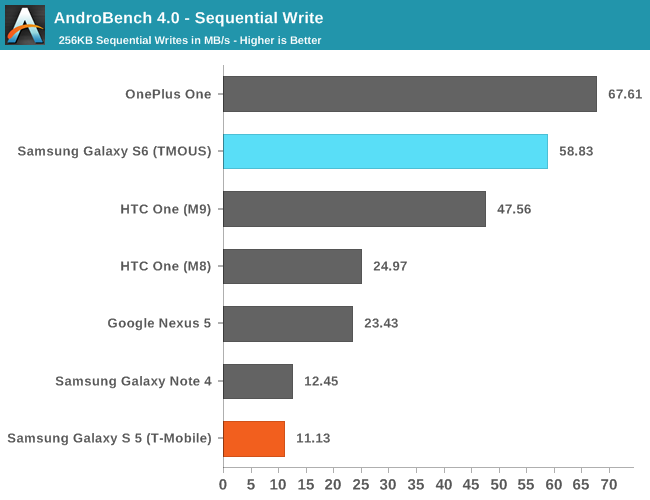
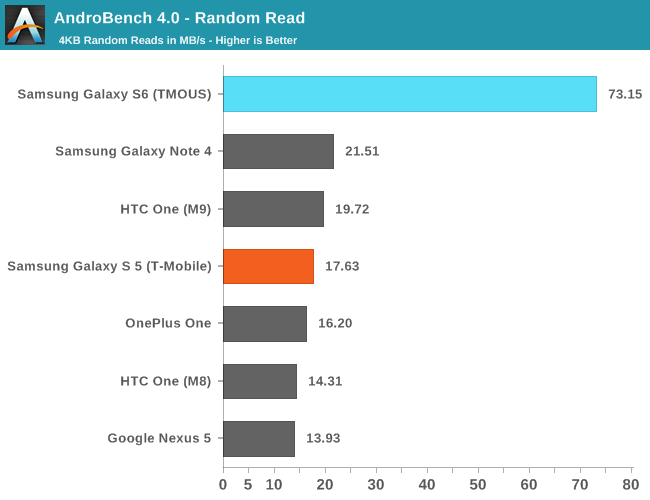
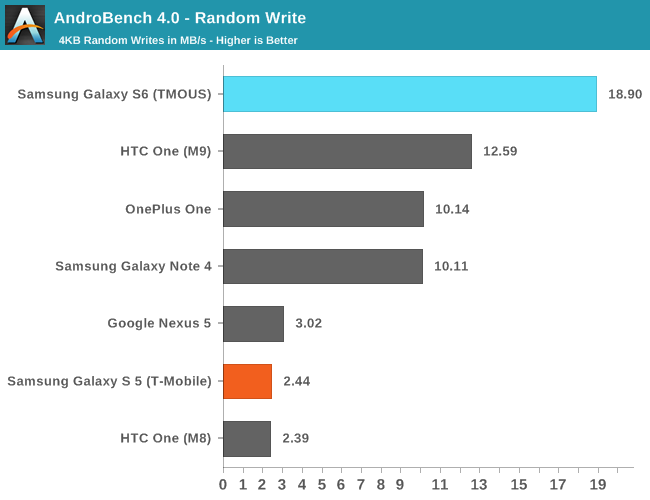
Overall, there are some immense benefits in storage performance here, especially in random IO performance. The Galaxy S6 has some of the fastest storage available in a phone today as far as I can tell given that this is basically a pure MLC solution, and shouldn’t have any real issue with storage performance holding back the rest of the phone over the course of 1-3 years as long as a reasonable amount of free space is kept to allow efficient storage management.


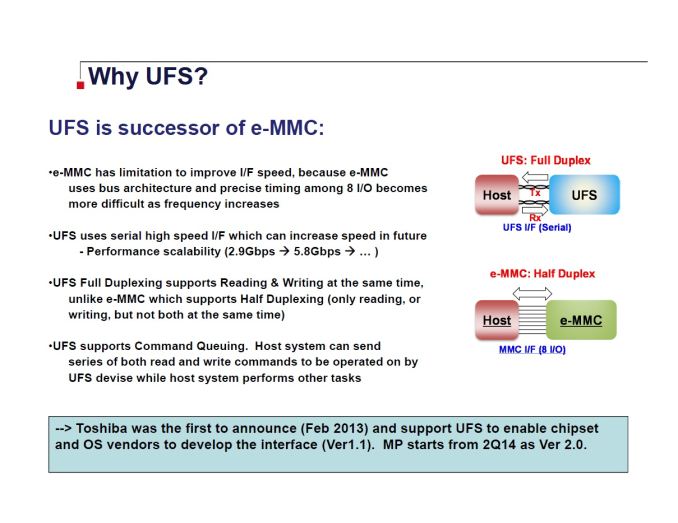








306 Comments
View All Comments
CrazyElf - Friday, April 17, 2015 - link
I just hope the Note 5 comes with expandable storage and a removable battery.Equally annoying is that it as lost waterproofing. On paper at least, it should be easier to waterproof a phone with no removable battery. That and accidents happen. The glass back too is form over function. Give us a metal back or something like carbon fibre.
whiteiphoneproblems - Friday, April 17, 2015 - link
Playing with the Edge, I noticed that the curves of its screen create undesirable light reflections. Any comments on this?JoshHo - Friday, April 17, 2015 - link
I noticed interference effects as well, which is discussed in the display section. Overall there are some notable compromises with the edge with relatively little benefit. Combined with the steep price increase and I find it hard to justify buying one over a 64 GB GS6.whiteiphoneproblems - Saturday, April 18, 2015 - link
Thanks - sorry to make you repeat yourself.nyonya - Friday, April 17, 2015 - link
Great review! Any chance you guys will get a Verizon or Sprint variant? Would love to see the battery life tests with the Qualcomm modem in those.victorson - Friday, April 17, 2015 - link
Nothing about the front facing camera?Ammaross - Friday, April 17, 2015 - link
It's a selfy-cam. Don't like it? Take pictures in the bathroom mirror like the rest of them. I doubt Skype et al pixelated video chat will care about slight distortions at the edge of the FoV or slight aliasing for striped objects, etc. :Pjohnnohj - Friday, April 17, 2015 - link
The S5 (and Note 4?) used to have a serious problem with edge distortion on the front-cam. I wonder if it's present on the S6.See this thread for examples http://forums.androidcentral.com/samsung-galaxy-s5...
akdj - Sunday, April 26, 2015 - link
I've got the Note 4, can't comment on the S5. I've never used one. But the Note 4, if so inclined allows you to take 'selfies' with the front (main) camera. You set your phone where you want it (actually according to where you want you;)) -- it looks slick. I've never used it. You frame/focus/lock exposure where you'll be 'posing' yourself or with a group. Take position. It recognizes a face. Flashes a light, counts down a couple seconds and snaps.Regardless, they're using a nice wide aperture and high megapixel selfie cam (that also shoots decent 1080p video for conferencing). It's definitely a step 'up' from most of the competition including the iPhone (I'm ambidextrous, the 6+ is my personal phone. I run our business with the Note4). Note 4's 'selfie' cam definitely beats up on my iPhone's. But then again, FaceTime is extremely cool, more reliable than Skype and convenient that Voice. Be cool if one of the three would open their face 'facing' software as open source/X-Platform, secure and not subsidized by data mining/search dollars or near trillion dollar company servers like Apple's.
More n more fills are using this camera, not necessarily for selfies but conferencing and team meetings. Between the two I've got, while the Note's is a better face cam IMHO, it's slight. And that's for both front and rear. They're both phenomenal in comparison to the 2007 iPhone I owned, the '08 Android, and any iPad or Xoom/Nexus I've owned --- and with a ten year old son, going through Google's Drive photos/Picassa and iCloud, both of which I was using pre 2007 for email and DSLR & visual storage or transfer, I'm now able to watch my son grow up in front of the computer.
So much different than my mom's photo albums of my three younger brothers ( all of us married, with kids now) & I.
These cameras and their storage software/data management subsystems have grown in leaps and bounds in the past couple years ...ita going to be interesting in thirty years to see what my son's 'photo albums' look like. If you were born in the last decade, your entire LIFE will be online and documented photographically
Practice Safe Selfies! I've got stories from friends about watching 'slide shows' with their teenagers or college kids that are hilarious! I'm not so sure they need to improve selfies significantly -- beyond today's capabilities. There's a fine line between too much detail and improved clarity on a wide angle closely focused, and hence distorted facial or grainy 'length' shots. I think nearly all selfie cams suffer not only edge distortion but soft corners/vignette, low resolution, tiny sensors and bad skin tones. They're more than fine for casual web shots but I don't want to see the pores of the race of the person I'm chatting with. Too distracting!
akdj - Sunday, April 26, 2015 - link
Ugh!*Edit* paragraph two is supposed to say 'More folks' not fills.
**Edit 2** last, main sentence '..the (f)ace of the person I'm chatting with!'
J